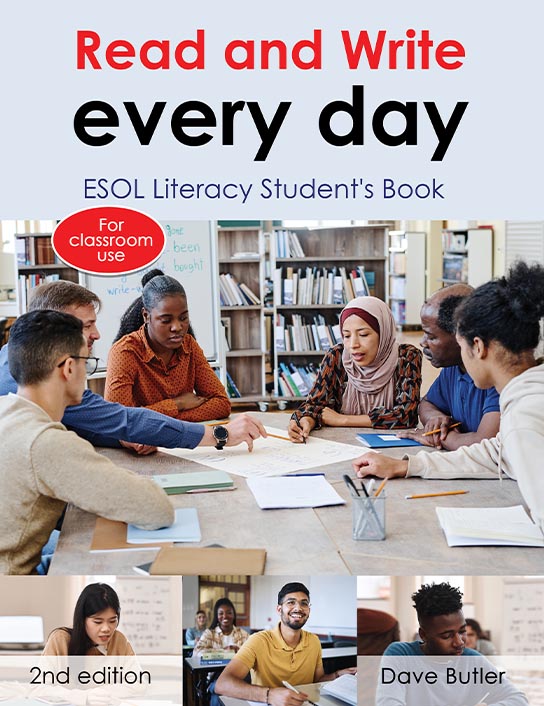The first day teaching a new group of learners is always exciting and a little nerve-racking for all those involved. While many ESOL Literacy / pre-entry teachers will have their own lesson for the first day with a new group, some who are new to this level may be interested in my tips and lesson plan for the first day with a group of basic ESOL Literacy (pre-entry) learners:
Tips
1. Smile a lot!

New students may well be worried about a room of new faces and whether they’ll understand what’s going on around them so a big smile helps settle everyone down. It’s also a good idea to reassure the group in the first five minutes that there will be time at the end to ask the teacher for help if they have any problems as there are usually students who are keen for help with funding / bursaries / childcare etc.
2. Have clear aims
This may be obvious but it’s worth emphasising. What do you want to get out of your first session? Nowadays I go in with these aims:
-
- The teacher and students get to know each other.
-
- Find out a little about the students’ level, especially speaking, reading and writing.
-
- Set a few basic ground rules, e.g. attendance, time-keeping.
-
- Help students with any pastoral care, e.g. enrolment/ funding/ student services.
3. Don’t plan too much
I’ve gone into class in the past with an all-singing, all-dancing lesson plan and a stack of worksheets. After 30 minutes, five students arrive late as they had gone to the wrong classroom. At break time, half the class ask for help with their bursary. You abandon the lesson that took you hours to prepare as there simply isn’t enough time. I’ve learnt the hard way that it’s therefore much better to leave that amazing lesson for day two!
4. Keep it simple

It’s a low-level class and the students aren’t yet used to their new teacher, e.g. the way you give instructions, the types of tasks you set. Avoid any activity that is at all complex! Remember that modelling tasks (doing the first question of an exercise together as a group) is much clearer for students than wordy instructions.
My plan for the first class
1. Ice-breaker

After checking everyone’s in the right room (!), I get the students into a speaking task very early on in this first lesson. I briefly introduce myself (“My name is Dave. I am your teacher”), I then set a simple speaking task to run in groups of 3: say hi to your classmates. Model with your own presentation (“Hi, my name is Dave, I’m a teacher, I’m from England. Nice to meet you!”). Help with pronunciation by drilling the key phrases: “My name is ….”; “I am from”; “Nice to meet you”; “Nice to meet you too.”
I get the students into this first speaking task within the first five minutes and with minimal preparation for the following reasons. Firstly, I want to warm up the class and relax the students as soon as I possibly can and speaking tasks in small groups are the best way to do this. Secondly, I want to get an idea of their speaking level, i.e. this is a diagnostic tool, so I don’t include the usual stage where I pre-teach useful language and vocabulary.
Chat to the groups while monitoring. Use this as a diagnostic stage – what is the level of the students’ speaking? Who stands out as particularly strong / weak? After the students have chatted, nominate a few learners to speak about themselves and ask a few follow-up questions. For instance, if a student tells you they like football you could ask, “Do you like watching or playing football? Where do you play?” etc.
2. Class mingle
Following the ice-breaker in small groups, my next aim is to give the students some language they can use in a longer presentation. This is partly to improve upon the speaking from the first stage, partly to bring in some language which the students can use in subsequent reading and writing stages.
In terms of error correction, I don’t do too much on the first day as I’m just trying to get an idea of the general level. However, if there is a common error that you’ve noticed from the ice breaker, that could be clarified at this point, e.g. “Some people said, ‘I live Glasgow’…. Do we say ‘I live Glasgow’? We say I live…?” to elicit the correct form.

I then bring in some more complex sentences to use in introductions through a few pictures on the interactive whiteboard: the flag of my country, my son, my bike and a picture of someone playing cricket. I tell them my name and elicit some personal details, e.g. “Where am I from?” (England); “Who is he?” (your son); “What do I like?” (cricket and your bike). I then model the next speaking task (introducing yourself): “My name is Dave. I am from England but I live in Glasgow. I live with my girlfriend and my son. I am a teacher. I like cricket and my bike.” If the group seem strong enough then more advanced phrases could be introduced, e.g. “I have been in Glasgow for 15 years.” Drill the phrases the students will use, e.g. “I live in Glasgow.” Also, clarify and drill the phrase, “Nice to meet you.” Get everyone up on their feet for a class mingle where they meet all of their classmates. Mingle and chat yourself too but, as last time, use this as a diagnostic tool to get a further idea of the students’ level.
Again, nominate a few learners to speak about themselves and ask a few questions. Note that these opening stages are purely oral, thus playing to the students’ strengths, allowing them to get to know each other without the strain of any reading/writing tasks.
3. Reading and Writing diagnostic
See if the students can remember personal information about you by asking questions such as, “Where am I from?” and “What’s my job?” Write this on the board as a brief text, for example, “My name is Dave. I am from England. I live in Glasgow. I am a teacher. I like cricket and my bike.” After hearing the teacher read the text aloud, the teacher and students read aloud as a group. Monitor while the students copy the text but mostly as a diagnostic tool to gauge the general writing level. Pair the students up to read the text aloud, monitoring while they do so. Help them while they are on task but hang back as much as possible as this too is a diagnostic tool, this time to get an idea of their reading level. If a student is really struggling here, however, make sure you give some help as we certainly don’t want anyone to become demoralised in the first class.
Use a student as a model for the subsequent writing task. Include the group by asking questions such as, “What is her name? Where is she from?” in order to build a text which you board and read aloud, e.g. “My name is Asma. I am from Sudan. I live in Glasgow. I am a student. I like college and the gym.”
I would usually add some stages here to help prepare the group before they write a personalised text but on this first day, as I want to get an idea of their writing level, I don’t. Instead, I remove the text and see if anyone can write about themselves without copying as a diagnostic tool. In saying that, the last thing we want is for anyone to feel out of their depth so I allow anyone who is struggling to look back at the earlier text about the teacher in their notebook and use it as a crib sheet. Again, I monitor but mostly with a diagnostic aim, noting any common issues. For example, if many have problems with letter formation or writing on the line then this is an area you could work on in a future class. Note who stands out as the strongest writers. Does anyone strike you as stronger or weaker than the others?

Finally, the students read their texts aloud in pairs before employing the look-say-cover-write-check (LSCWC) method, sentence-by-sentence, to rewrite their texts. LSCWC is a common method to memorise how to spell individual words whereby students cover a written word with their hand and then write it again before checking they have spelt the word correctly. The same idea can be used with a text the students have written.
4. Housekeeping and rules
It’s important to go through the most important rules for the class. Elicit these from the students, by asking questions such as, “What time do we start class?” On the first day, I keep this quite snappy and plan a longer focus on this for the next class but it is important to make the rules clear, whatever they are in your institution. For example, if good attendance is essential then students need to know that they will lose their place/travel bursary if they don’t attend. Clarify important information such as room numbers too.
5. Pastoral care

As I mentioned earlier, there are always a number of learners looking to resolve issues such as bursaries or childcare. I’ve made the mistake in the past of finishing class and then spending half of my lunch break fielding students’ queries! Get an idea during the class of who needs help (e.g. just before break time, ask who needs help and tell them you will do so at the end of class) and then finish early to give yourself plenty of time for this support.
What about day two?
Whilst this lesson doesn’t involve any material, I use our course book for ESOL Literacy students, ‘Read and Write every day’ starting on day two. For more details and to order copies, click here. More blogs to follow soon with tips and sample pages.

Feedback
I hope the tips and plan here prove helpful. Please feel free to comment below with any feedback or any of your own tips for day one with a new group.

4 Responses
Thank you Dave for your helpful insights into the first lesson with a pre-entry class. I like your emphasis on speaking activities, how you introduce the writing task and use both as diagnostic tools. I will be using your ideas when I begin my ESOL teaching career on Saturday. Thank you very much for sharing.
Thank you so much Jenny for your kind feedback. I find that plenty of speaking tasks always manages to warm the class up nicely. Good luck on Saturday!
Thank you so much for sharing all this really helpful and practical advice, Dave. I have just received the Read and write every day books which I ordered, and look forward to using them with our students. Good luck to you, your colleagues and all your students for this academic year.
Thank you Joanna! I hope you find the books useful and good luck to you and your learners too!